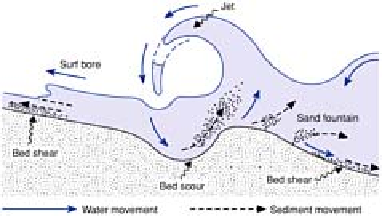Environmental Engineering Reference
In-Depth Information
evacuate the swash zone. All processes can be observed during foreshore paddling in
appropriate,
safe
conditions!
Figure 17.5
Plunging wave form and associated water and
sediment transfers.
Source: After Carter (1988).
COASTAL EROSION
Erosion occurs through hydraulic action, the mobilization of sediments and their attrition
and corrasion. It is most effective under storm wave conditions. Breaking waves apply a
hydraulic shock or hammer effect, by trapping water or compressed air ahead of the wave
and inducing negative pressure as it retreats. Compressive stress is maximized in
plunging waves and when the wave front is vertical, trapping air between crest and
trough. The effect of repeated cycles of hydraulic shock and negative pressure depends
on the structure and lithology of Earth materials. High compressive stress is dispersed
along fractures in hard, fractured rock and may generate secondary tangential - i.e.
shearing - forces. Together they critically reduce or exceed shear strength and trigger
rock-mass failure. Individual blocks are quarried and entire rock walls are undercut and
destabilized, controlled by the exposure of rock fractures relative to the eroding waves
(see Chapter 13). Many coastlines show exemplary structural control of cliff form and the
geometry of bays and headlands (Plate 17.1). Similar hydraulic forces accelerate erosion
when waves attack coastlines in unconsolidated materials. Soft glacial sediments form
many mid- to high-latitude coastlines and changing dynamics may convert formerly
constructive or stable coasts into easy erosion targets. Corrasion and attrition result from
the abrasive action of suspended and bed loads in wave and current environments.
Corrasion of bedrock or other fixed surfaces is probably restricted to the nearshore, and
the backshore zone within reach of wave spray. Attrition occurs as in any other
environment with loose particles in regular, moving contact with each other. Beach
shingle acquires among the highest mean clast roundness.
COASTAL WEATHERING
Sub-aerial weathering processes assist coastal erosion by their progressive reduction of
material strength. Particular emphasis is placed on wetting and drying cycles around the
intertidal zone and on the presence of salts. The intertidal zone and adjacent areas within

